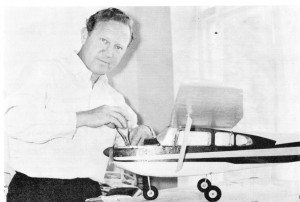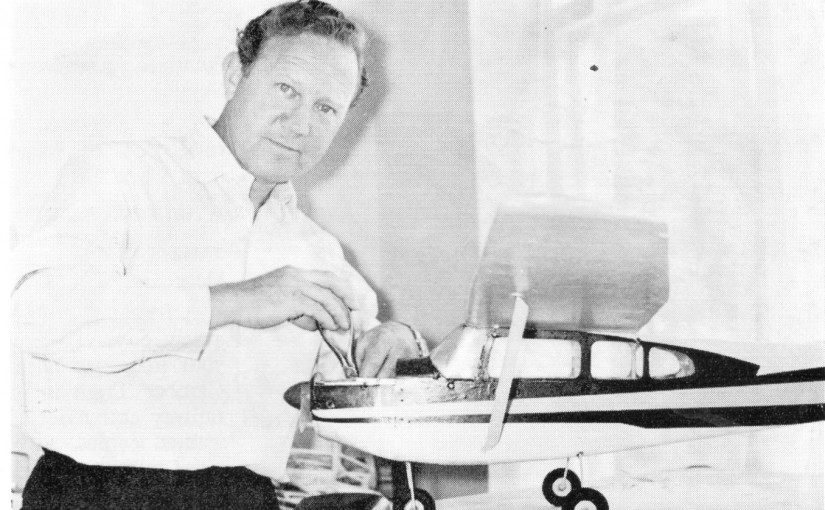IT’S A MODEL WORLD No. 3
Albert Victor Sanders of Mill Place, Rye has been a keen Aircraft Modeller for thirty years. He first built solid models for display but then progressed to the skeleton type covered with a thin skin and capable of being flown.
Albert’s first models were purely aircraft in representation, but he became interested in models of actual aircraft and soon began to build scale models.
In pre-war days Rye had a large Model Aircraft Club with some thirty members. Albert represented the club in flying competitions and exhibitions.
Nowadays all Mr. Sander’s models are built from kits or plans, they are power driven and remote controlled. He flies each model until it is no longer of any use then he removes all serviceable parts and builds them into a new model.
Models cost about £30 each to build, the wood is quite cheap but the engines are expensive, although they can be used again in later models.
Albert has nine models in his collection at the present time, all are fitted with pneumatic tyres and each took about three weeks in the building. Mr. Sanders enjoys flying his radio controlled models the best.

MODEL AIRCRAFT AS A HOBBY
by A. V. Sanders
Model aircraft may be said to date back to 1848, when Stringfellow built his model, which was the first to actually fly. The remains of this original model can still be seen in the Science Museum, South Kensington. However, it was not until 1907 that the first model aeroplane competition was held, this being won by Roe (later to become Sir A. V. Roe) with a model using rubber as a motive power. A few years after this, model flying began to come popular and by 1911 many clubs came into exstence.
Such is a very brief outline of the early days of the model aircraft hobby and it is interesting to occasionally look-back to those days and compare the advancement that has taken place with today’s highly developed flying models.
Model aeronautics, like other forms of model engineering, has the enjoyment of original design and the pleasure of constructional work incorporated in it, and also has the additional interest of testing the result of one’s work when it comes to flying.
This is probably the greatest appeal in favour of model aviation for to see a model aeroplane, that one has taken many hours to build, rise off the ground under its own power, climb steadily to a height of 100ft. or more, circle overhead for some time and then commence a long graceful glide, and finally land, is a sight which must be seen to be fully appreciated.
The hobby of building and flying model aircraft has no age barrier, it can be enjoyed by both young and old alike and also cater for different levels of skill. Nowadays the models range from simple, easy to build rubber powered aircraft or non-powered gliders, to elaborate, fully detailed models of full size aircraft, the latter being powered by miniature diesel fuel engines and in most cases equipped with a radio guidance system which enables the operator to control the movements of the model in the air, from a transmitter on the ground.
To the uninitiated, perhaps a few words of friendly advice may not be out of place, for whilst not wishing to damp any enthusiasm, it should be pointed out that there are difficulties which may beset the newcomer to model flying, and it is therefore better at the outset for him to start with the very simple and easy to fly model before attempting to build a machine of more elaborate form which requires greater skill and fuller knowledge of aerodynamics to prevent the model crashing on its first flight.
In conclusion, it is hoped that these few remarks may go to illustrate in some small way the possibilities of model flying as a scientific hobby and as a sport of no mean order. Nowadays the whole family can join in the fun at a day’s outing to a model flying contest of which there are many up and down the country. Full flying programmes are arranged and meals of the barbecue kind are usually available.
From “Rye’s Own” November 1967
